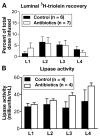Antibiotics Suppress Activation of Intestinal Mucosal Mast Cells and Reduce Dietary Lipid Absorption in Sprague-Dawley Rats
- PMID: 27436071
- PMCID: PMC5391873
- DOI: 10.1053/j.gastro.2016.07.009
Antibiotics Suppress Activation of Intestinal Mucosal Mast Cells and Reduce Dietary Lipid Absorption in Sprague-Dawley Rats
Abstract
Background & aims: The gut microbiota affects intestinal permeability and mucosal mast cells (MMCs) responses. Activation of MMCs has been associated with absorption of dietary fat. We investigated whether the gut microbiota contributes to the fat-induced activation of MMCs in rats, and how antibiotics might affect this process.
Methods: Adult male Sprague-Dawley rats were given streptomycin and penicillin for 4 days (n = 6-8) to reduce the abundance of their gut flora, or normal drinking water (controls, n = 6-8). They underwent lymph fistula surgery and after an overnight recovery were given an intraduodenal bolus of intralipid. We collected intestinal tissues and lymph fluid and assessed activation of MMCs, intestinal permeability, and fat transport parameters.
Results: Compared with controls, intestinal lymph from rats given antibiotics had reduced levels of mucosal mast cell protease II (produced by MMCs) and decreased activity of diamine oxidase (produced by enterocytes) (P < .05). Rats given antibiotics had reduced intestinal permeability in response to dietary lipid compared with controls (P < .01). Unexpectedly, antibiotics also reduced lymphatic transport of triacylglycerol and phospholipid (P < .01), concomitant with decreased levels of mucosal apolipoproteins B, A-I, and A-IV (P < .01). No differences were found in intestinal motility or luminal pancreatic lipase activity between rats given antibiotics and controls. These effects were not seen with an acute dose of antibiotics or 4 weeks after the antibiotic regimen ended.
Conclusions: The intestinal microbiota appears to activate MMCs after the ingestion of fat in rats; this contributes to fat-induced intestinal permeability. We found that the gut microbiome promotes absorption of lipid, probably by intestinal production of apolipoproteins and secretion of chylomicrons.
Keywords: APOA-I; APOA-IV; Digestion; Microbe.
Copyright © 2016 AGA Institute. Published by Elsevier Inc. All rights reserved.
Conflict of interest statement
The authors disclose no conflicts.
Figures







Similar articles
-
Effect of L-Glutamine on Chylomicron Formation and Fat-Induced Activation of Intestinal Mucosal Mast Cells in Sprague-Dawley Rats.Nutrients. 2022 Apr 24;14(9):1777. doi: 10.3390/nu14091777. Nutrients. 2022. PMID: 35565745 Free PMC article.
-
Activation of rat intestinal mucosal mast cells by fat absorption.Am J Physiol Gastrointest Liver Physiol. 2012 Jun 1;302(11):G1292-300. doi: 10.1152/ajpgi.00011.2012. Epub 2012 Mar 29. Am J Physiol Gastrointest Liver Physiol. 2012. PMID: 22461027 Free PMC article.
-
Apolipoprotein A-V is present in bile and its secretion increases with lipid absorption in Sprague-Dawley rats.Am J Physiol Gastrointest Liver Physiol. 2015 Dec 1;309(11):G918-25. doi: 10.1152/ajpgi.00227.2015. Epub 2015 Oct 1. Am J Physiol Gastrointest Liver Physiol. 2015. PMID: 26505974 Free PMC article.
-
Mucosal permeability and mast cells as targets for functional gastrointestinal disorders.Curr Opin Pharmacol. 2018 Dec;43:66-71. doi: 10.1016/j.coph.2018.08.011. Epub 2018 Sep 11. Curr Opin Pharmacol. 2018. PMID: 30216901 Review.
-
The Role of Interstitial Matrix and the Lymphatic System in Gastrointestinal Lipid and Lipoprotein Metabolism.Front Physiol. 2020 Jan 22;11:4. doi: 10.3389/fphys.2020.00004. eCollection 2020. Front Physiol. 2020. PMID: 32038309 Free PMC article. Review.
Cited by
-
Gut microbiota and immunity relevance in eubiosis and dysbiosis.Saudi J Biol Sci. 2022 Mar;29(3):1628-1643. doi: 10.1016/j.sjbs.2021.10.068. Epub 2021 Oct 30. Saudi J Biol Sci. 2022. PMID: 35280528 Free PMC article. Review.
-
The Role of the Gut Microbiota in Lipid and Lipoprotein Metabolism.J Clin Med. 2019 Dec 17;8(12):2227. doi: 10.3390/jcm8122227. J Clin Med. 2019. PMID: 31861086 Free PMC article. Review.
-
Effect of β-Glucan Supplementation on Growth Performance and Intestinal Epithelium Functions in Weaned Pigs Challenged by Enterotoxigenic Escherichia coli.Antibiotics (Basel). 2022 Apr 13;11(4):519. doi: 10.3390/antibiotics11040519. Antibiotics (Basel). 2022. PMID: 35453270 Free PMC article.
-
Intestinal lipid absorption and transport in type 2 diabetes.Diabetologia. 2022 Oct;65(10):1587-1600. doi: 10.1007/s00125-022-05765-8. Epub 2022 Jul 30. Diabetologia. 2022. PMID: 35908083 Review.
-
Interaction between microbiota and immunity in health and disease.Cell Res. 2020 Jun;30(6):492-506. doi: 10.1038/s41422-020-0332-7. Epub 2020 May 20. Cell Res. 2020. PMID: 32433595 Free PMC article. Review.
References
Publication types
MeSH terms
Substances
Grants and funding
LinkOut - more resources
Full Text Sources
Other Literature Sources
Medical

